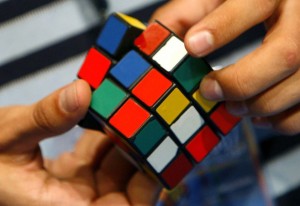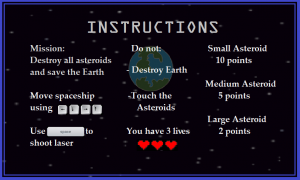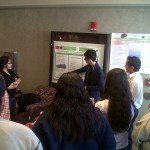For the past month or so, I have been working in Scratch, trying to create a game. I started with a simple football game of pong. It was finished with a week so I decided to move on to something harder. I decided to work on Flood It, a game with the objective to make the entire board one color, by starting at the top left corner and changing the color of adjacent blocks. I began with simply creating the backdrops, one for the intro (which includes instructions and a start command) and the starting backdrop (just a black screen). The only commands I wrote for the backdrops, was to clear the screen when the flag was pressed
Rosa – Nexus 2014
July 18th, 2014Denise nexus 2014
July 9th, 2014Lately, I’ve been working on making the classic game Mastermind on Scratch. It has been going well and it has been a learning experience being new to Scratch. One of the first challenges I faced when making the game was how to display the guesses the user made each time and how to give hints on the guesses they have made. I have also had to change the layout of the game at least twice to make it easier for the sprites to move and look at least semi-organized. The game is almost completely functional with one exception as the game does not process duplicate numbers well. It’s a minor bug which is probably due to some math inconsistencies that I am fixing. I have also been meaning to simply make it look better simply for the sake of vanity. I’m hoping to improve it possibly making it more user friendly but with some harder levels in order to make it more challenging.
I have also been looking into game theory to make it a part of my other project for the summer. Since the beginning of my light-research on the subject I have found it to be more interesting then I previously thought. Also, it has shed some light on certain aspects of economics that I had previously not understood. Most of my research has been through videos on game theory. I have not found any books that are easier to digest than text-books. I will keep looking.
Mirka NEXUS 2014
July 9th, 2014I am working on a videogame made on Scratch, it is a Version of the Asteroids game , but it consists on different graphics (of Spaceship, asteroids, laser, Earth) rules, and scoring. The game objective is to score the greater number of Points after the game is over. A life is gone every time an Asteroid touches the ship. If the laser touches the Earth, the game will end inmediately, without considering the number of lives left. Asteroids exist in three sizes; big, medium and small, each have a different value of points ( Large = 2pts, Medium = 3pts, Small=5pts ) which are added to Points, duplicated and time is subtracted from that value to get the score. A high Score Memory is included and can be erased with “reset High Score”button wich appears when game is over with number of points, time and Final Score. The difficulty of the game increases gradually depending on the Score that you have, if score increases, the velocity of steroids will increase each Level reached. It is an endless game, the only way to stop is losing the 3 lives provided or destroying the Earth .
Evelyn Nexus 2014
July 9th, 2014I’ve been developing my own 2048 game on Scratch, the project has given me many problems but am slowly coming to a working game. Some problems have included getting blocks (sprites) to combined, getting the blocks to stay with in a grid, and costumes change when blocks touch. However, I have been figuring out how to fix these problems one step at a time. After getting the major problems finished I believe I can fix any minor changes afterward, such as getting the blocks to stay in the lines with out touching the outside the boundary and bouncing back in.
Other than my game I have also been consulting Mirka on a second project in which we decided to build a robot that does art. We have been looking into building an arm, what will draw a scanned picture. We got the idea after seeing something called Sketchbot. We hope to start on the project Friday.
Nexus Interns – 2011
July 5th, 2011Hello, we are the 2011 Nexus interns for Dr. Ceberio from Da Vinci. This summer is special in that it has two projects to it. First is an app for Droid phones that compares two DNA sequences and displays those that match together and the second is an AI in python using Minimax that plays connect four on a 3D board.
First, let’s talk about the app since we did that first. We used the Google’s app inventor to create the app first doing tutorials then moving on to the task at hand. The application has two text boxes that you put your string of DNA into, then it tells you if they are the same or not and lines up the two strings showing lines between the ones that match up and blanks where they don’t match up. The lines used to not match up properly due to the characters being different sizes but we solved that by putting several spaces between the characters when they are displayed.
Our second project was the 3D Connect Four AI that is designed to play the game and win against another AI made by the community college students. The game itself was made by Christian Del Hoyo and we added the intelligence agent. Our initial approach was to use Minimax, which is an AI that would follow a tree of decisions, branching out into different actions depending on what the player did. Unfortunately, a Minimax program was beyond our abilities so we settled for a large list of if statements that changed based on what the opponent played and random variable that selected the list of ifs that should be used.
NSF CAREER project activities
November 22nd, 2010Although most of the activities of CR2G are reported on each of the pages of this website, here you can read about the activities of CR2G working on the NSF CAREER project of Dr. Ceberio. In particular, you have access to the reports of the team, as well as the articles (once they have been accepted).
Disclaimer: Any opinions, findings, and conclusions or recommendations expressed in this material are those of the author(s) and do not necessarily reflect the views of the National Science Foundation.
Open Positions
July 8th, 2010News:
- November 2011 — 1 PhD position available for Spring 2012!!! We are currently looking for one PhD student for a position as a Research Assistant. The ideal candidate students will have experience in C++ (and possibly MatLab); all should have an interest in theory, problem solving, and numerical problems.
- [PAST] July 2010 — 5 positions available for Fall 2011 and after!!! We are currently looking for two Master’s students and 3 undergraduate students in Computer Science to fill two positions as Research Assistants. The ideal Master’s students will have experience in C++ (and possibly MatLab); all (undergrad and grad) should have an interest in theory, problem solving, and numerical problems.
Nexus interns — 2010
June 17th, 2010
I’m back this semester to continue my internship and complete my Rubik’s cube project. I have barely started working on the robot again. The few glitches are almost all fixed and we found a way to make the cube easier to move. The only problem that we are currently facing is the inaccuracy of the color sensor. My goal for this coming month is to design and build a new robot. I’m hoping that this new design will have less problems than the previous one and that it will work more accurately. However, building and testing the tilted twister has helped in giving me an idea of what to expect and inspired the concept of the new robot design. So far, I have been doing mainly research and trying to learn the basics of a new programming language. I will be sure to continue updating this semester.

This is our model robot, A.K.A. the Tilted Twister.
This week has been a very productive one indeed. We finally have a sample robot built and we ran a premade program on it just to see how the robot works. You can click on the link below to get a glimpse of the robot. Click this link to see the video: Tilted Twister. We’ve decided to program the robot using Robot C which is compatible with the LEGO NXT Brick (the brain of our robot). I’m currently working on writing an algorithm, with the help of the group, that can solve the first part of the Rubik’s Cube. The robot was having some mechanical problems with the color sensor while we were testing it out last week, so I will be sure to take a look at that this week. The robot is also very sensitive to the slightest difference in position of the cube so we will need to take that into consideration. Additionally, the following link is to the website where I found the robot design: www.tiltedtwister.com.
Hi, I’m Andrea Rivera, I’m also a summer intern from Harmony Science Academy. I’m also quite excited to be working with UTEP’s Computer Science Department, I must say it’s a pleasure to be working with such intelligent people here. Unfortunately I haven’t been able to find the time to post and update my reports until now, thankfully my schedule is clearing up so time will not be a problem anymore and I will be able to post my reports.Well, my interest is in biomedical engineering so, the project I’ve chosen to do is to design and build a robotic arm to cut into a model of the human body and perform a hepatectomy, which is the surgical removal of the liver, or pancreatectomy. So over the past couple weeks I’ve come up with a prototype design for a robotic arm and simplified it to have 6 degrees of freedom (DOF) as too many DOF’s would be very difficult to code for, at this point simplicity is key. I’ve also chosen a scenario and have started building the arm as well as began learning RobotC which is the language I plan to program the robot in. So far the project has gone alright, however I’ve been having a bit of trouble learning RobotC but that’s nothing an extra hour of practice can’t help. The real question now is if my design needs to be changed further.

The Rubik’s Cube project is going really good. We finally figured out how to solve the cube ourselves with the help of a few tutorials. Solving the cube itself is pretty tricky. Although there are algorithms that aid you in solving the cube, you can never be sure that your individual cubes are going into the right position on the faces of the cube. However, a human can determine whether those cubes are on the right faces by reasoning with the colors. The robot, on the other hand would be following an algorithm which would limit its ability to be able to recognize these errors and continue its program. So our problem now is, how can we write an algorithm that would give the robot the ability to recognize and reason with the different problems on the cube?

I’m Roya Edalatpour, the new summer intern for the CR2G Research Group from Harmony Science Academy. I am really excited to be working with such wonderful and brilliant people in the UTEP Computer Science Department. For my research project, I have chosen to build a robot that can solve the Rubik’s Cube. With the help of Dr. Ceberio and her students, we are hoping to be able to achieve this. This week, we focused on the design of the robot and what type of physical constraints the robot would have. Basically, our strategy is to build a robot, test different algorithms, and eventually build up and improve on the design over time and experience. But for now, I’ve been working on finding a solution to the Rubik’s Cube so that I can solve it as well.
Here, you can find the progress report of Andrea and Roya who have joined CR2G for summer 2010.
MSEIP EPCC TM and UTEP CS
June 17th, 2010Summer 2010: CR2G is in charge of coordinating projects offered to high schools students of El Paso who are part of the Early College High School program with EPCC.
Dr. Ceberio is coordinating the effort while Luis Gutierrez and Luis Martinez (two active members of CR2G) are instructors for the two students who chose our project this summer.
Current information about the progress of the project can be found on the facebook page of the project.
The four projects that were proposed this summer are on:
- genetic algorithms for optimization;
- the solar system and the automation of given scenarios;
- gravity and constraints;
- prime numbers in scratch and their applications.
Research Day @ UTEP, April 10, 2010
April 13th, 2010- Luis Gutierrez
- Luis Gutierrez
- Luis Gutierrez
- Paden Portillo
- Paden Portillo
- Paden Portillo
- Shubhra Datta
- Shubhra Datta
- Shubhra Datta
- Mario Bencomo
- Mario Bencomo

















